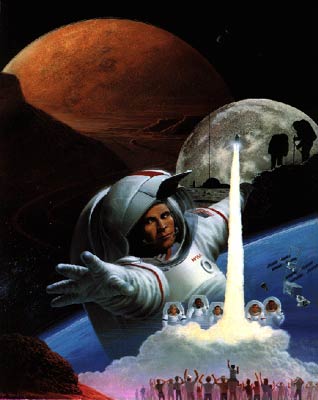Sagan’s rationale for human spaceflightby Michael Huang
|
| Pale Blue Dot: A Vision of the Human Future in Space found a rationale that not only justified human spaceflight, but raised it to the highest importance. |
In medieval times, some people kept a human skull in their home to remind themselves of mortality, and to view their priorities against the big picture of life and death. A modern equivalent is the dinosaur fossil. The fossilized remains of a once great and dominant species reminds the human species of our eventual choice: survival or extinction, or as Sagan put it, “spaceflight or extinction”.
A technological civilization that lives on the surface of a single planet has inevitable threats to its long-term existence. Current threats—impacts from space, nuclear or biological war—will be joined by new threats from emerging technologies. Even if all these threats are detected, solutions such as disarmament or relinquishment are incomplete or politically impossible.
We will have to live with these threats, just as we have been living under the threat of nuclear war. This requires that we live in a way that will withstand a catastrophe if it occurs: living at multiple locations throughout the solar system, and living with the assistance of life-supporting technologies.
Space technology, despite its name, is not limited to space. Technology designed for the extremes of space can be used in any extreme environment. If a catastrophe made Earth hazardous for life, space technology will sustain life in space and on Earth. This is happening now. NASA aims to use spacesuit technologies in a suit for homeland security: a protective suit for environments contaminated with biological or chemical agents.
Science cuts two ways, of course; its products can be used for both good and evil... The technologies that threaten us and the circumvention of those threats both issue from the same font. They are racing neck and neck.
This new race is not between nations or ideologies; it is a race between powerful technologies. Will we use science and technology to end life or support it? Intercontinental ballistic missiles or interplanetary launch vehicles, nuclear weapons or nuclear power plants, biological and chemical weapons or life support systems, weapons of mass destruction or technologies of mass life?
What is Carl Sagan’s vision?
If we were up there among the planets, if there were self-sufficient human communities on many worlds, our species would be insulated from catastrophe… A cataclysmic impact on one world would likely leave all the others untouched. The more of us beyond the Earth, the greater the diversity of worlds we inhabit… then the safer the human species will be.
| The more of us beyond the Earth, the greater the diversity of worlds we inhabit… then the safer the human species will be. |
There is a renewed effort—by governments, companies and individuals—for a small fraction of humanity to live independently beyond the Earth. One way to assist the colonization of the solar system is to spread Sagan’s message to a larger audience. The popularity of Cosmos was due to its exceptional use of television. Its sequel Pale Blue Dot deserves an equally inspirational documentary film or television series. Similar documentaries could be based on William Burrows’s The Survival Imperative: Using Space to Protect Earth (to be published in 2005) or Martin Rees’s Our Final Hour: A Scientist’s Warning: How Terror, Error, and Environmental Disaster Threaten Humankind’s Future In This Century—On Earth and Beyond (2003).
Human spaceflight and the survival of the human species are ideal subjects for the screen. Hollywood has produced memorable human spaceflight films, such as 2001: A Space Odyssey and Apollo 13, and the epic disaster is one of Hollywood’s favorite genres. These visuals would work equally well in the documentary format. Narrations of quotations (see Space Quotes to Ponder) and interviews with experts would convey the history and current status of the idea.
SpaceShipOne’s Ansari X Prize breakthrough brought the world’s attention to the idea of personal spaceflight. Hopefully, a documentary will do the same for another important idea.
